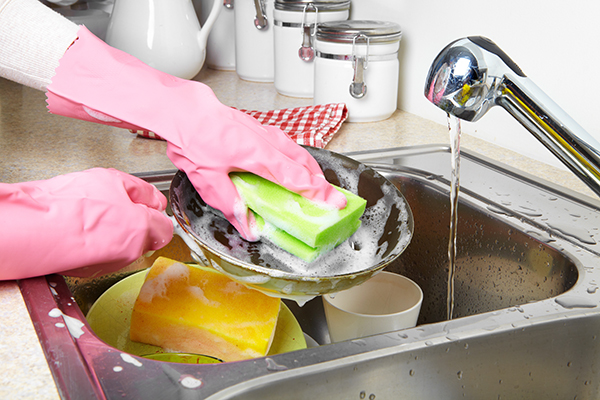Strategies for Hand Hygiene Effectiveness
In our second blog this month, the topic of hand hygiene continues (and really, it should never go away!) with a focus on strategies to achieve in a foodservice operation. Numerous studies, and likely your own observations, have concluded that efforts to wash hands will depend on the amount of time available, ease in accessing handwashing sinks and supplies, and structure of work tasks. There is no question that the foodservice work setting can be chaotic, especially during peak meal times. While there is a tendency for managers to continually push for greater output in less time, we suggest those in charge of a foodservice take a step back and take a look at how employees are completing tasks. Maybe some coaching with them on taking a few minutes to get organized and plan how and when tasks will be completed can result in the need for less handwashing and greater productivity, which will result in them feeling more energetic as there is less “spinning of wheels” and more mindful actions. Managers might consider a strategy called “swarm scheduling”, which involves multiple team members in a concerted effort to complete a job more quickly and require fewer handwashing occasions than when one person was tasked with multiple transactions. Here is one example, which is available in a video version on the Iowa State University Food Safety Project site as part of a USDA project called Do Your PART.
Job:
Make 100 sandwiches consisting of bread, meat and cheese slice, lettuce and tomato.
Plan:
Prepare mise en place (chef’s term for everything in its place) by taking bread from packages and stacking in pans, combining meat and cheese slices into portions and stacking in pan on ice, and pre-assembling lettuce leaf and tomato slices in portions in pan on ice. Each person has a designated pre-prep task, or one person completes in sequence with pans of cold foods held in refrigeration. When all preps completed, set up assembly line.
Assembly:
The swarm of workers each has designated role with one assigned only to supply the line with additional pans of prepped ingredients as needed and take prepared sandwiches to holding unit when tray completed.
Without the team approach, the sole person assigned to the task of making the sandwiches would have multiple handwashing and glove change occasions because of having to supply the line and store completed product (remember the refrigerator door handles are a high touch point).
The team approach can also be used throughout the work day. Help employees think in terms of “clean” and “dirty” and encourage them to help each other out. For instance, in front of house, assign some employees the job only of clearing tables (dirty) and others the task of only serving food and beverages (clean). In the dish room, one person loads soiled dishware and another unloads clean items and stores.
During the SafeBites Webinar earlier this week, some training ideas were presented along with other strategies. The webinar is archived in case you missed the original presentation.
Safe food is dependent upon good hand hygiene, which means employees need to wash hands when and how they should, and change gloves as needed to avoid contamination of foods. These actions mitigate the risk of foodborne illnesses. Risk Nothing!
READ MORE POSTS
Properly Cleaning and Sanitizing: The Right Chemical Mix to Maintain Ultimate Effectiveness
A few weeks ago, my family and I had the pleasure of setting sail on a cruise vacation. It is truly one of the only ways that I find that I am able to unplug from work and relax for a small spell. However, as I walked around the ship in our post-COVID world, I couldn’t help but admire all the extra cleaning steps the staff were undertaking to keep us all as safe as possible while in the middle of the ocean with 3,000 other vacationers. All of this cleaning and sanitizing had me thinking about how we each clean and sanitize our own operations and which chemicals we chose to use.
Proper Cooking Temperature: A Basic Food Safety Measure
Each summer, we see an increase in the incidence of foodborne illnesses. Perhaps this is because of the warmer temperatures making temperature control for Time/Temperature Control for Safety (TCS) food more difficult or perhaps it is the increased amount of people who are barbequing this time of year – it is National Picnic Month, after all!
Changing Climate: The Unseen Impact on Food Safety
In June, I was asked to participate in the Allinfoodz podcast, put on by a colleague, Dr. Amit Sharma, at Penn State University. One of the points Dr. Sharma wanted to discuss was the impact of climate change on food safety, which is something I was certainly aware of, but not something I had done much research on. However, when preparing for the interview and podcast, it was interesting to learn more about the relationship between the two.
Thawing Food with Food Safety in Mind
There comes a time in almost every foodservice operation where you must thaw food. Yes, I know there are those operations who have moved to fresh products only and don’t have a freezer in-house, but I am willing to bet that is more the exception than the norm. I am almost sure that anyone reading this blog who works in a foodservice operation can regurgitate what methods are acceptable to thaw food per the FDA Model Food Code. In case you don’t recall, I will discuss them briefly, but I wanted to spend some time covering these requirements a bit more in-depth – so you not only know WHAT to do, but the WHY we do it that way.










